With all of the focus on the Champions League in Europe and the narratives that surround it we can often lose sight of the fact that there are other interesting continental competitions around the world. The Copa Libertadores in South America gets a lot of attention now in Europe, mainly because of the history that South American sides have for developing young players, but the Asian Champions League is also growing in prominence as a result of the investment in football in the likes of Saudi Arabia. In this season’s competition, one of the most interesting sides from a tactical perspective have been the Thai side Buriram United who are coached by the young Australian coach Artur Papas. They are interesting because they are extremely flexible from a tactical point of view – a side that have caused a bit of a stir in the soccer betting world given their over-performance in this season’s Asian Champions League.
The purpose of this article is to provide an analysis of Buriram United under their Australian coach Arthur Papas. This season we have seen Buriram play in a variety of tactical systems which deserve further attention. The key aspect of their play, however, is that regardless of the system that they use they have a specific set of principles that guide the way that they play.
In terms of a young coach, there are few, if any, outside of Europe who are currently as interesting or as talented as Arthur Papas is.
Systems used
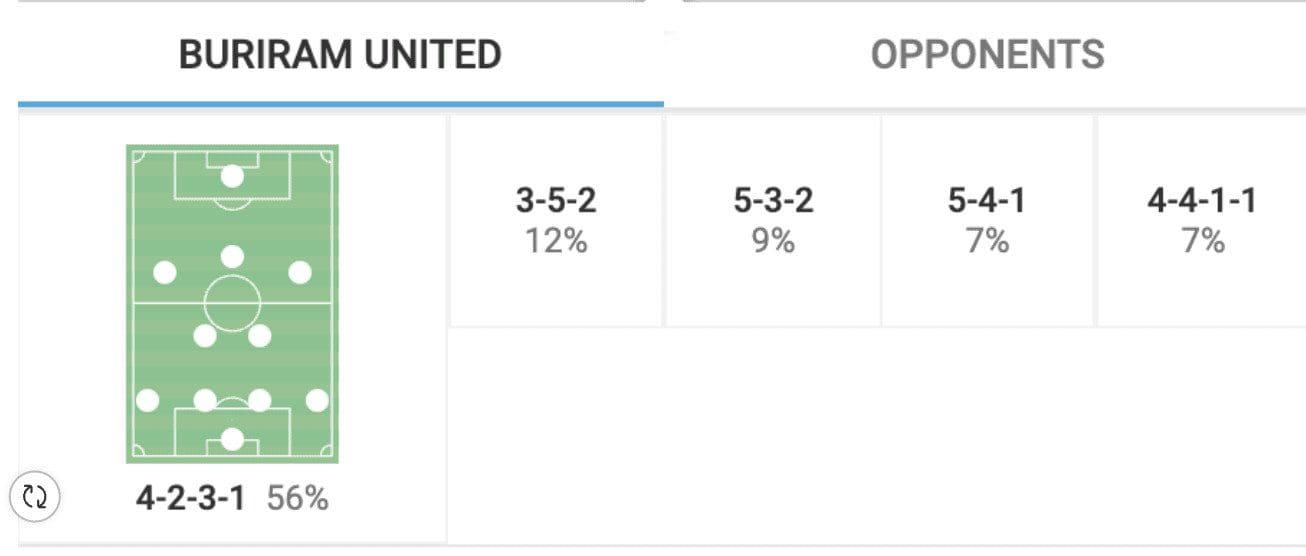
So far this season we have seen Buriram United, in all competitions, use five specific tactical systems. For the most part, they have played in a 4-2-3-1 system but they have also changed situationally to use a 3-5-2, 5-3-2. 5-4-1 and a 4-4-1-1 system. The ability to make structural changes to the shape of the team has been key for Buriram in some of their more high-profile results this season.
We can look more closely at the systems used in the Champions League across the first four league games of the competitions.
Matchday One – Vs Zheijang Professional
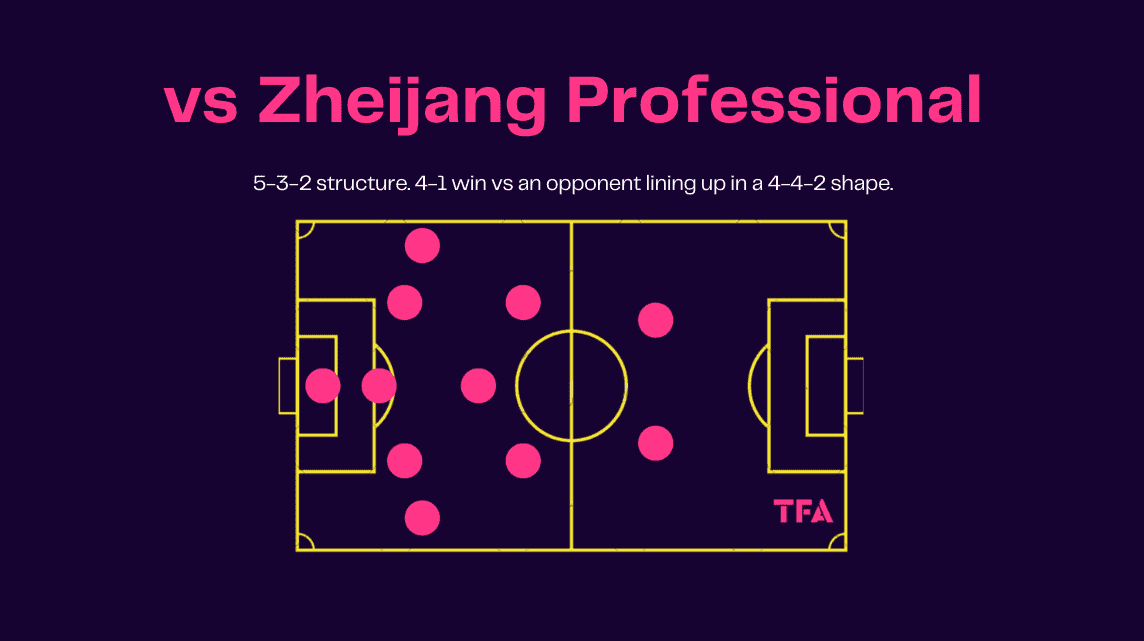
Against the Chinese side Zheijang Professional we saw Buriram United line up in a 5-3-2 structure with an emphasis on progressive attacking passing patterns that utilised the central spaces and the half-spaces with the fullbacks tasked with being in near constant motion to effectively provide width and create defensive compactness depending on the game state.
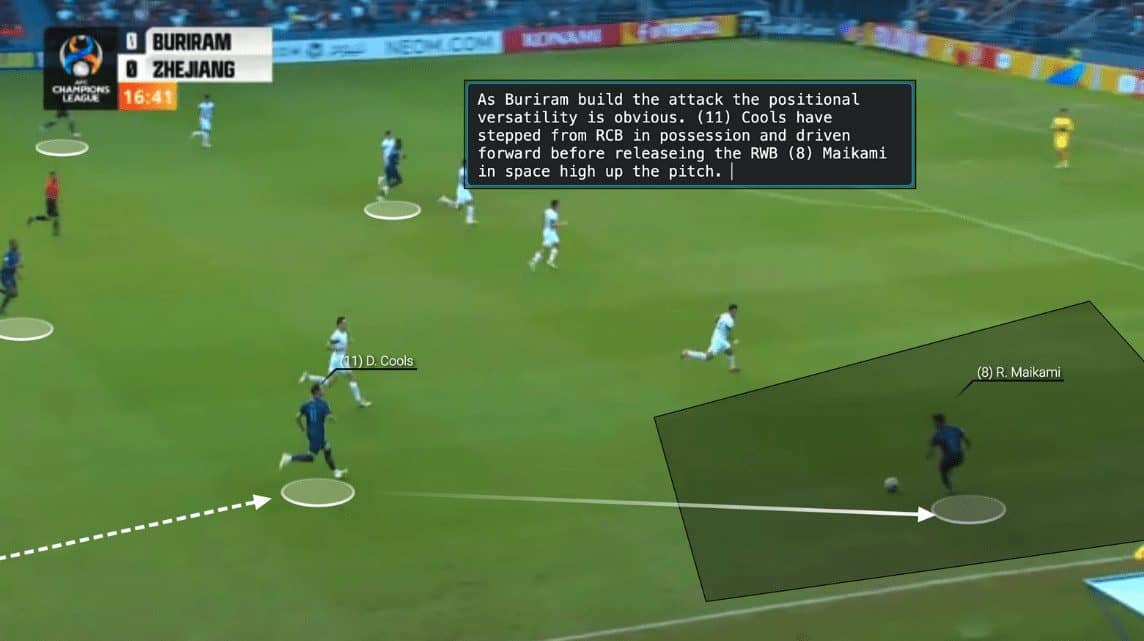
Throughout the match one of the most interesting aspects of the game tactically was the flexible approach that Papas wanted his side to take in possession of the ball. There were points in which the central midfielders would either hold a deeper line or rotate out into wide areas. When this happened we would see the fullbacks or even the wide central defenders take the opportunity to push and rotate into more advanced positions. This tactical and positional flexibility made it extremely difficult for the opposition from a defensive point of view.
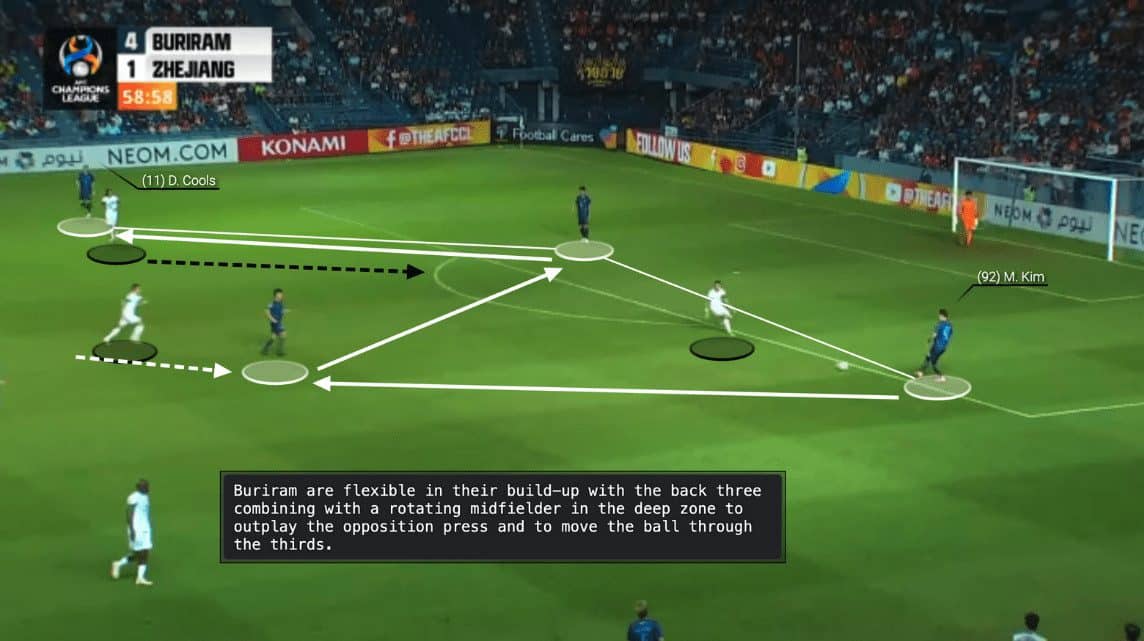
When they were building the attack from their defensive third in this match Buriram United were equally as interesting. They used one of their three central defenders to rotate back out towards the ball in order to create clear overloads against the initial press of the opposition. This allowed them to consistently find angles in order to outplay the opposition. By using rotating midfielders dropping in to receive in this way there was always an option to play centrally to pin an opposition player and to open an angle to progress the ball through.
Matchday Two Vs Ventforet Kofu
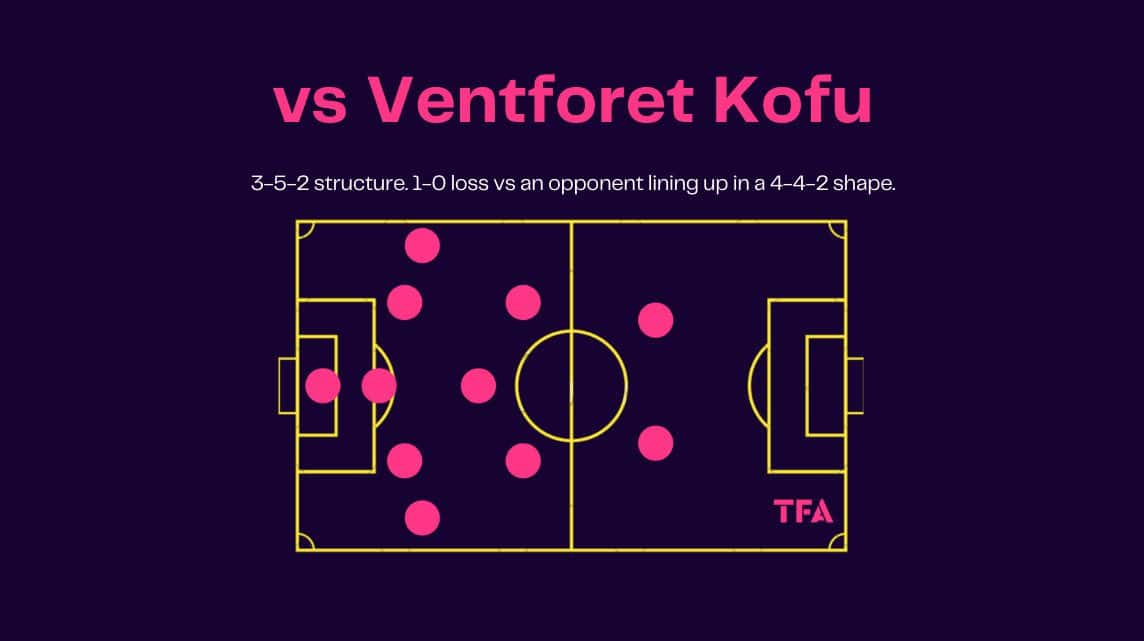
In the second matchday, we saw a 3-5-2 structure against the 4-4-2 of their Japanese opponents. The key difference in this game came in the positioning and behaviour of the fullbacks or wingbacks for Buriram United as they tended to play in more advanced position throughout the game as Buriram concentrated their attacks down the wide areas.
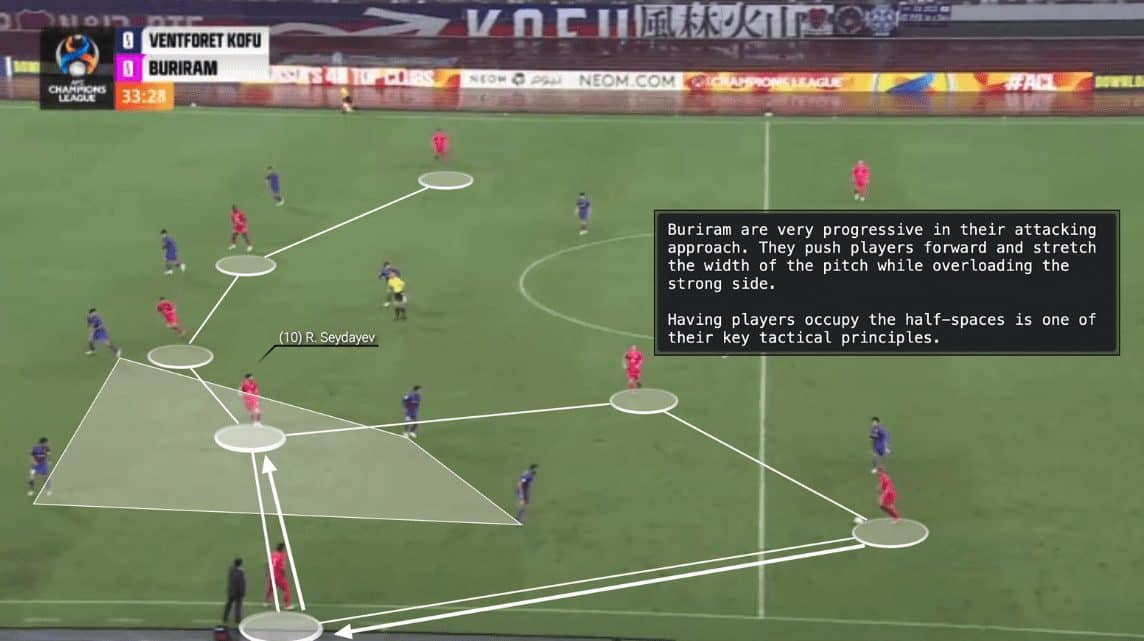
We see an example here of the way that Buriram United attacked down the wide spaces by rotating in advanced areas and creating overloads to outplay the opposition on the strong side of the pitch. The key player was often Seydayev who occupied the half-spaces and consistently gave his side a passing option into this zone as he was in pockets of space.
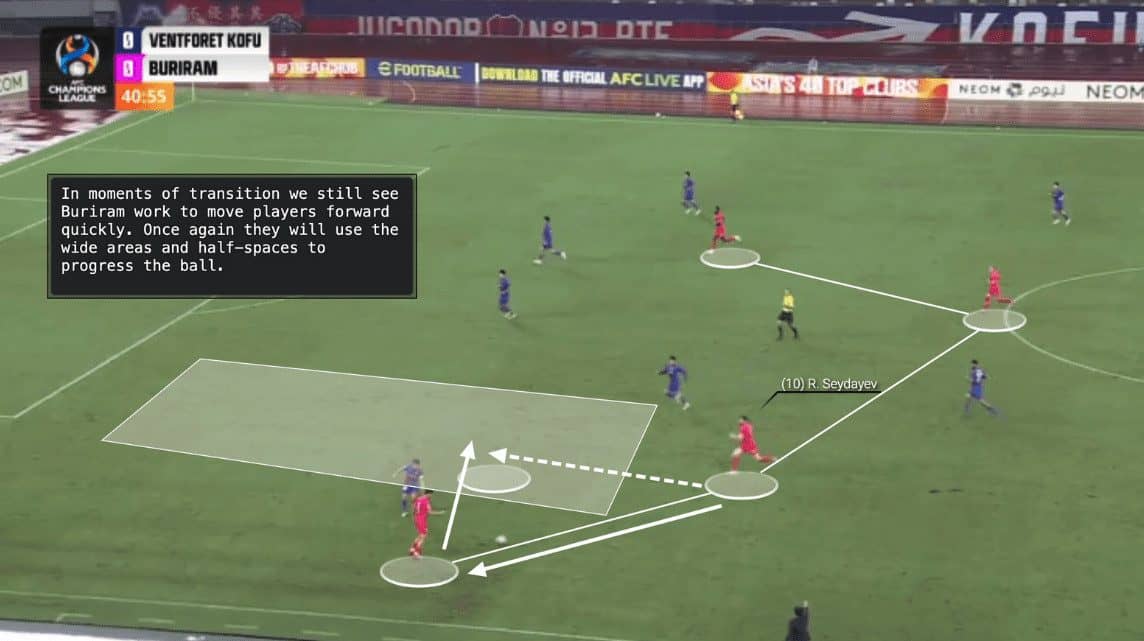
In more transitional attacking moments we also saw Buriram clearly use the wide areas and half-spaces to attack and break through the opposition defensive block. As they attacked quickly in transition they would occupy the wide spaces and with runners coming from deeper positions to attack through the half-spaces they are were able to consistently break through and create threat.
Matchday three Vs Melbourne City
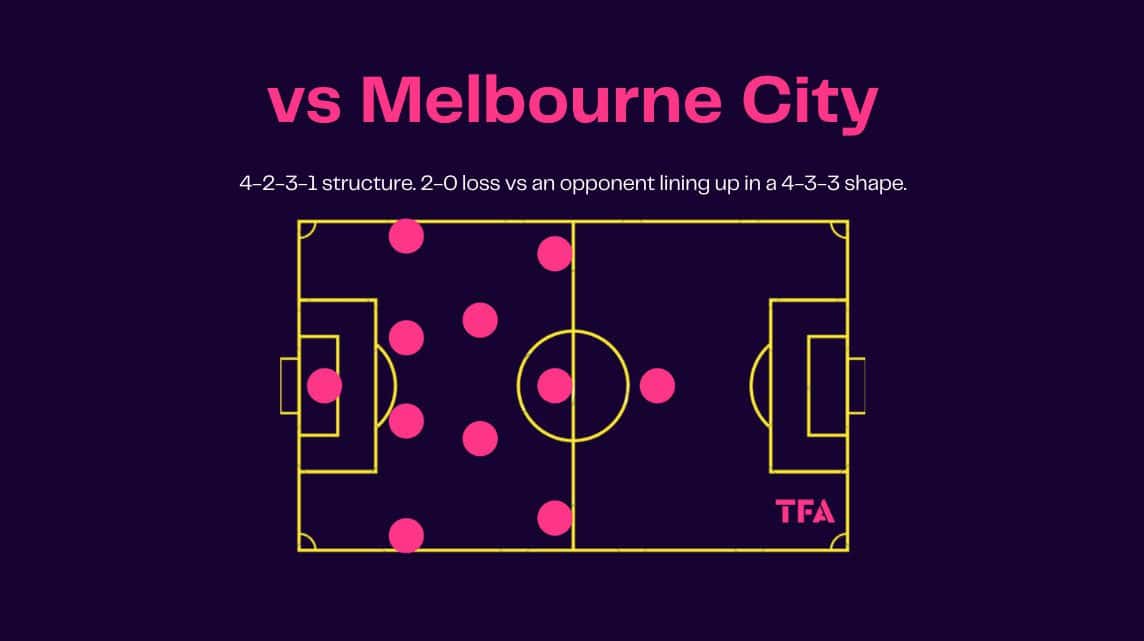
Next up we had the first of two matches Versus the Australian side Melbourne City as Papas again adjusted the tactical structure of Buriram United to play in a 4-2-3-1 against the 4-3-3 of the opposition. The key aspect for Papas as he changes and adjusts the shape and formation, however, is that the tactical principles that underpin the system remain constant. This allows his team to understand and process the information surrounding their system despite the pictures in terms of positions and shapes having changed.
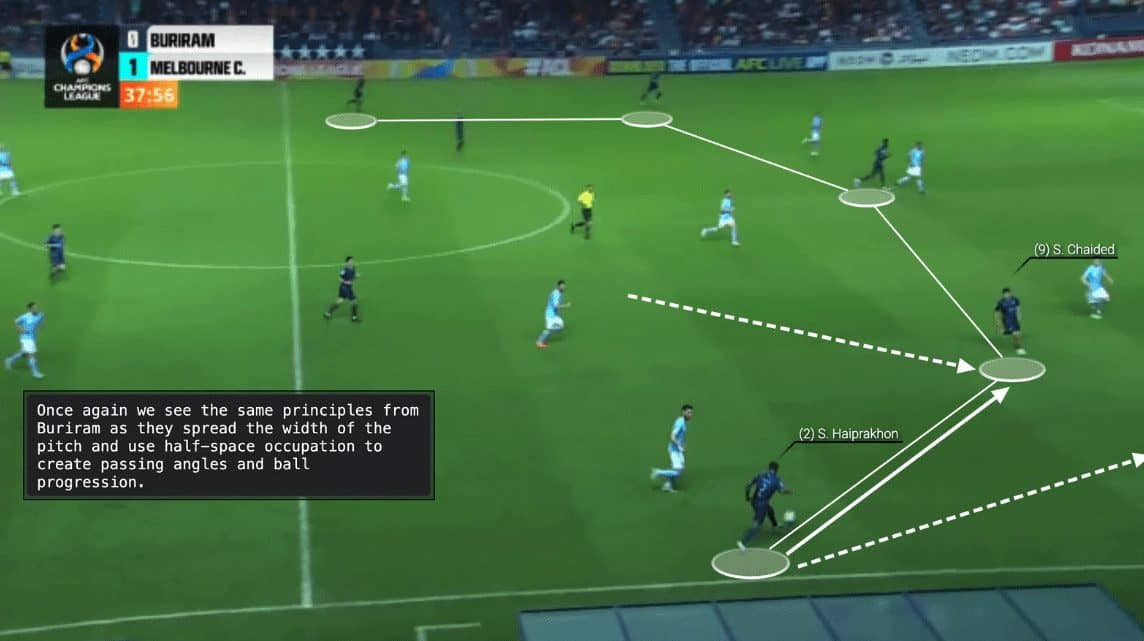
We see that here as, once again, the use of half-space occupation is one of the keys as Buriram attack the opposition. This time the movement of Chaided, playing as the 9, is key as he rotates out with a midfielder moving high and occupying the central position. This allows for the half-space to be used as he receives in this area before then continuing the attacking progression down the near side.
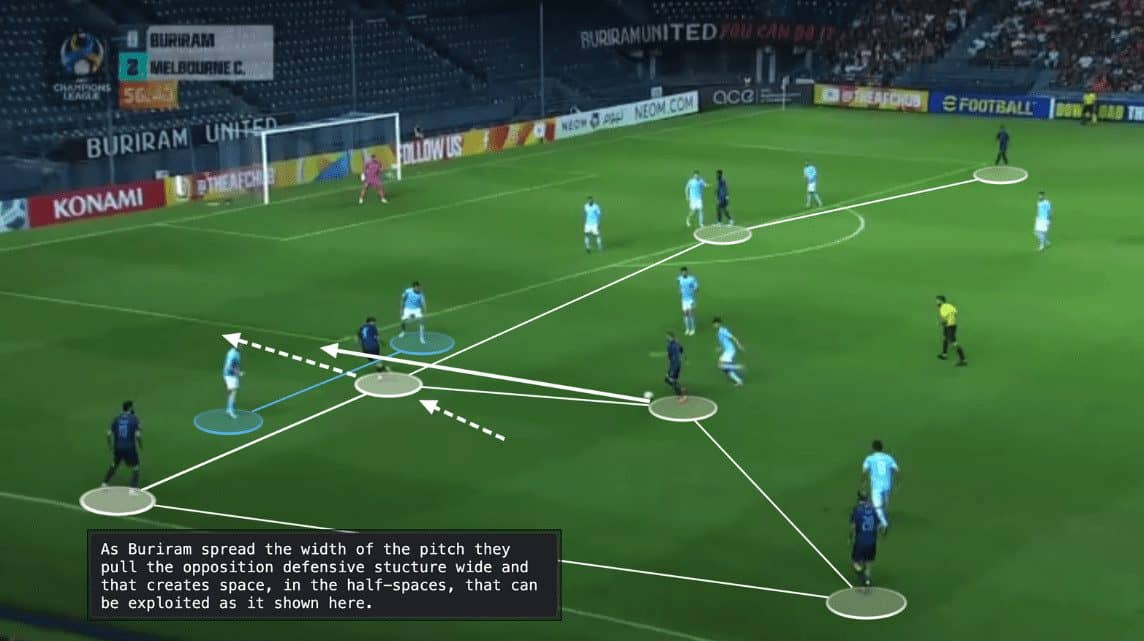
In using the 4-2-3-1 we saw Buriram use more immediate width in the attacking phase with the wide attackers holding the width and stretching the pitch. As the fullbacks moved high in the attacking phase we would then see more effective use of space as the opposition were forced to defend wide to counter the width. This meant that there was consistent space in the half-spaces and even centrally that could be exploited by forward runs to attack and exploit space.
Matchday four Vs Melbourne City
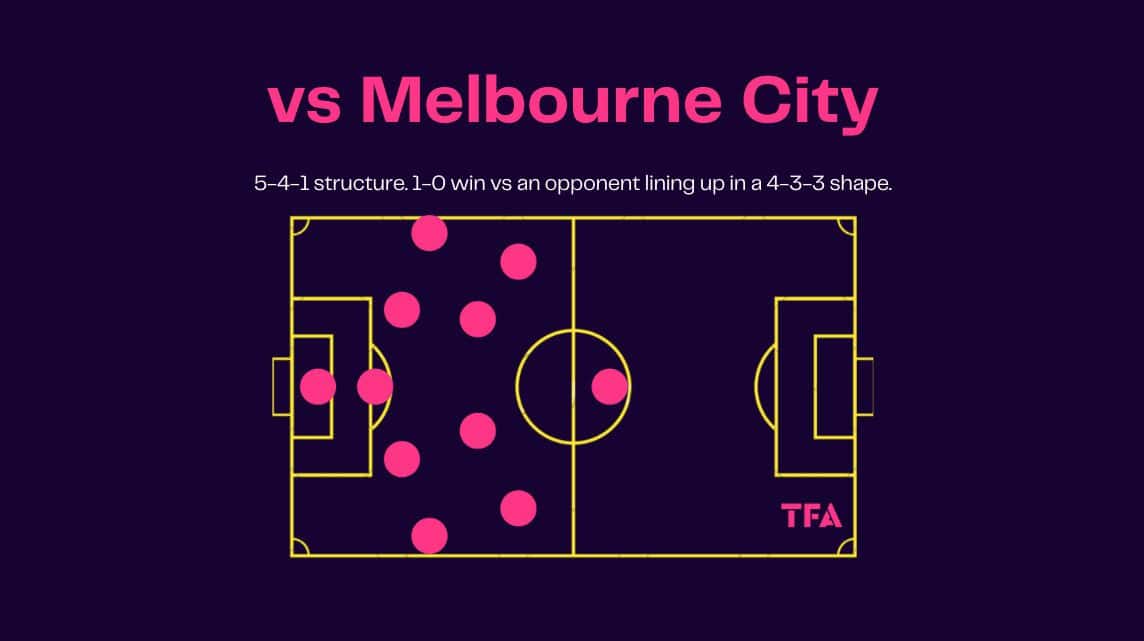
For the return group match against Melbourne City we saw Papas adjust the starting shape and positional look of his team as they shifted to a 5-4-1 shape against the same 4-3-3 shape from the opposition.
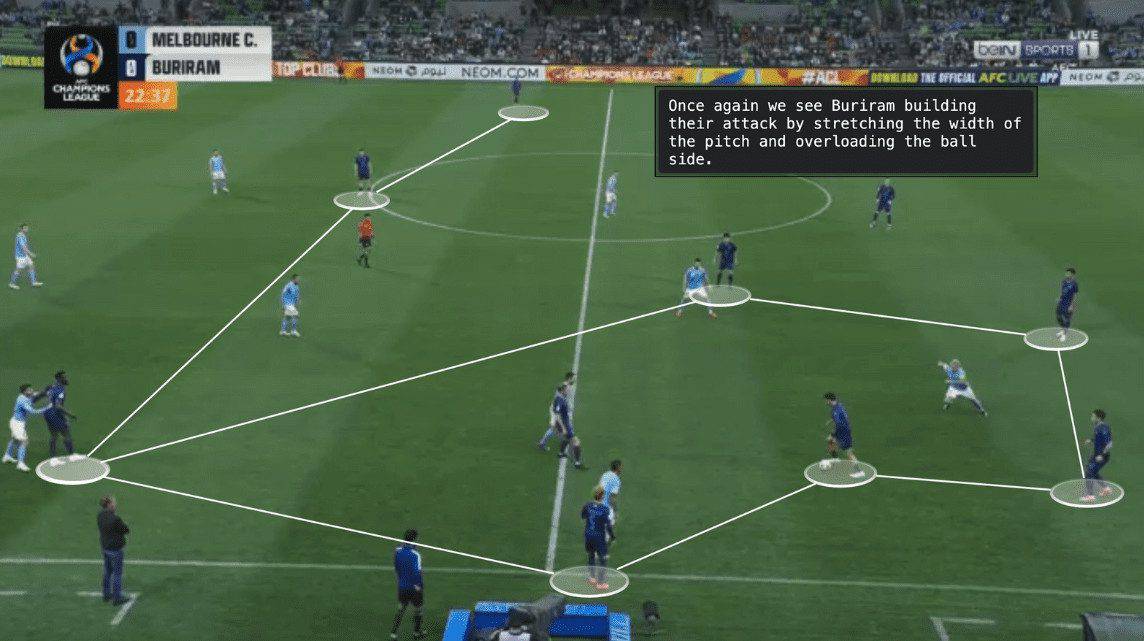
As you might have expected, however, despite the change in formation the tactical principles that underpinned the way that Buriram United stayed consistent. For example, we again saw the Thai side overload the strong side of the pitch as they progressed the ball forward but once again they still maintained the width on the weak side.
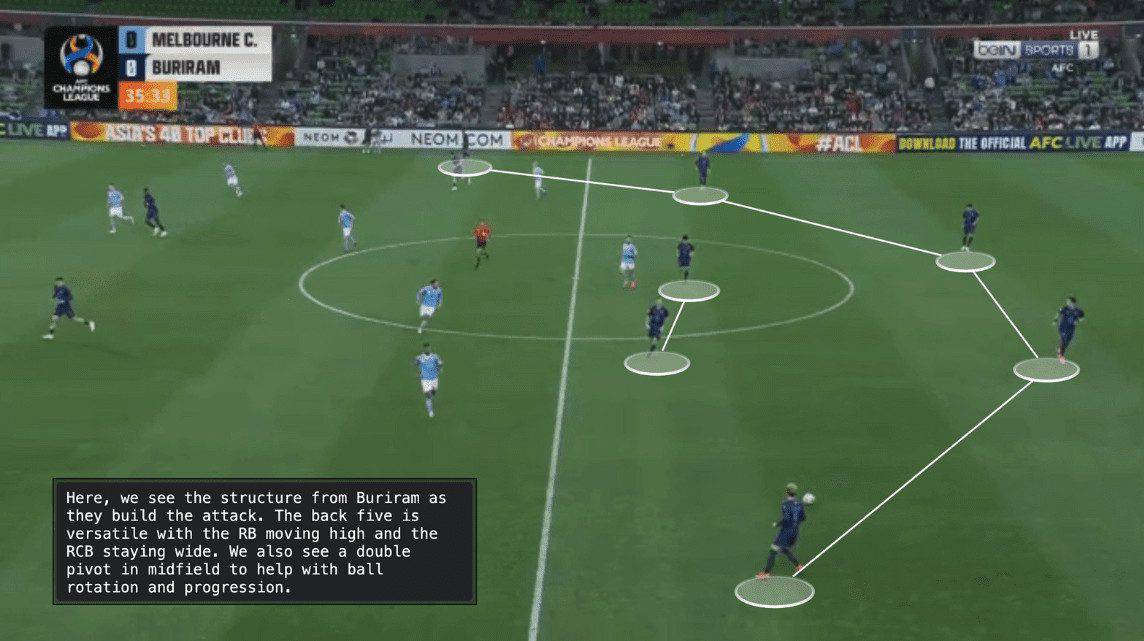
In terms of ball progression in the 5-4-1 it was extremely interesting to see that the two central midfielders maintained a close relationship in the double pivot. The back five would then rotate with one wingback/fullback moving higher while the other one stayed on the same line as the two midfielders. This shape was extremely effective for Buriram United as they built their attack and progressed the ball through the thirds.
In four Champions League matches we have seen Arthur Papas set his Buriram United side up in four different tactical structures. While this versatility is incredibly interesting it is underpinned by a set of sound coaching principles that allow him to move players around and deploy them in different positions. The different structures used by Papas are clever and they make it difficult for opposition coaches to properly play against Buriram. It would be beneficial for the purpose of this article to use data to further understand the principles behind Buriram.
Attacking phase
Starting in the attacking phase of the game we can use league-specific data to start to build a more full picture of both the underpinning principles behind Papas’ system at Buriram and the strengths of this system.
- 13.8 shots per 90 (2nd in Thai league
- 19.05 crosses per 90 (3rd in Thai League)
- 22.59 touches in the opposition area per 90 (1st in Thai League)
In terms of their play in the attacking phase, we can quickly build a profile of the team. They generate a high volume of shots per 90 but this is based around the way that they build the attack and with the highest in the league for touches in the opposition area we can see that they build patiently before accessing a shooting opportunity. Having the 3rd highest crosses per 90 in the league also tells us that they use the wide areas and half-spaces in the final third to access the penalty area.
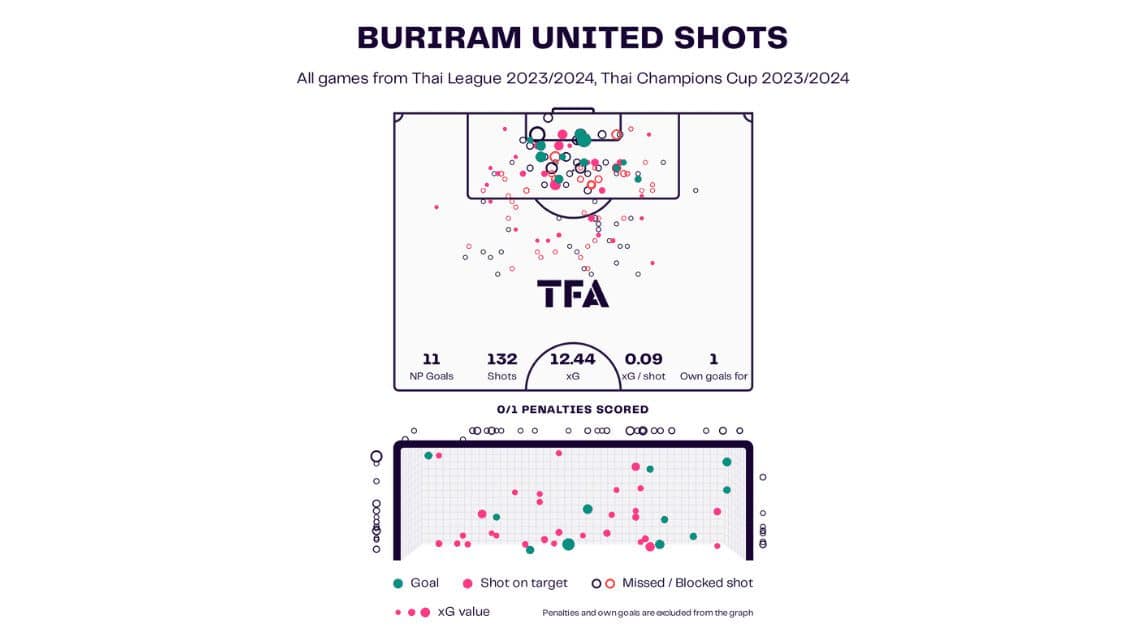
The shot map for Buriram United in the Thai League and the Asian Champions League at the time of writing is instructive in terms of the way that Buriram United looked to build the attack and create chances. As you can see at the time of writing they had 11 goals from an xG of 12.44 with all of their goals coming from within the opposition penalty area. They create high-value chances across the 6-yard box and despite some shots from outside the area they are, for the most part, creating higher-value chances.
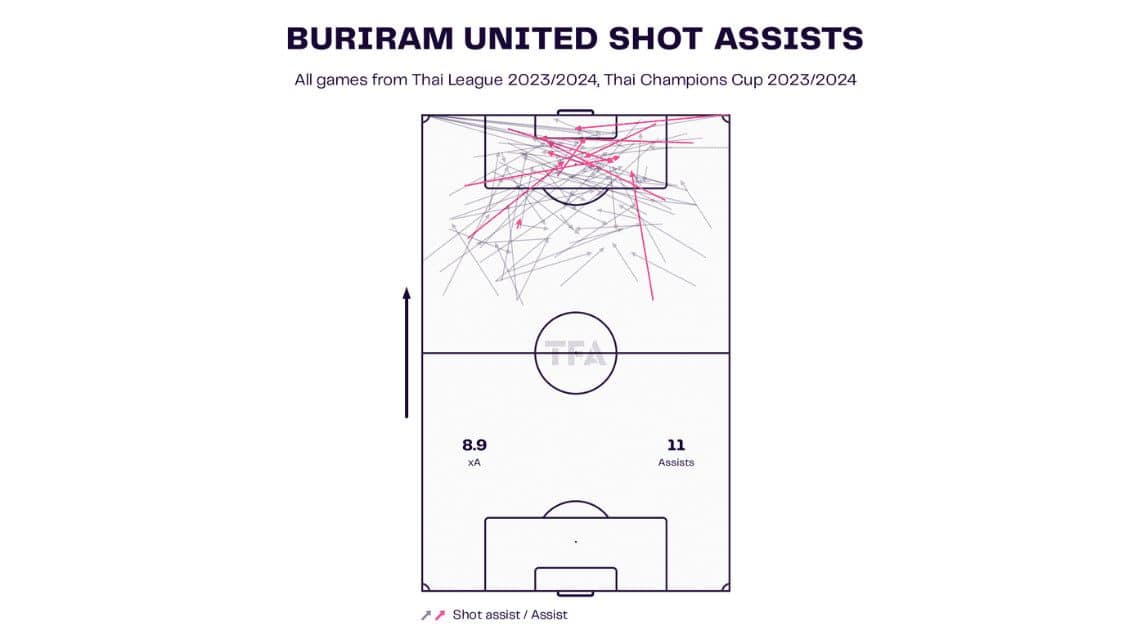
Once again when we consider the areas from which Buriram United are creating chances we see the importance of the half-spaces in the way that the Thai side build their attack. They find angles from these positions to penetrate into the opposition area.
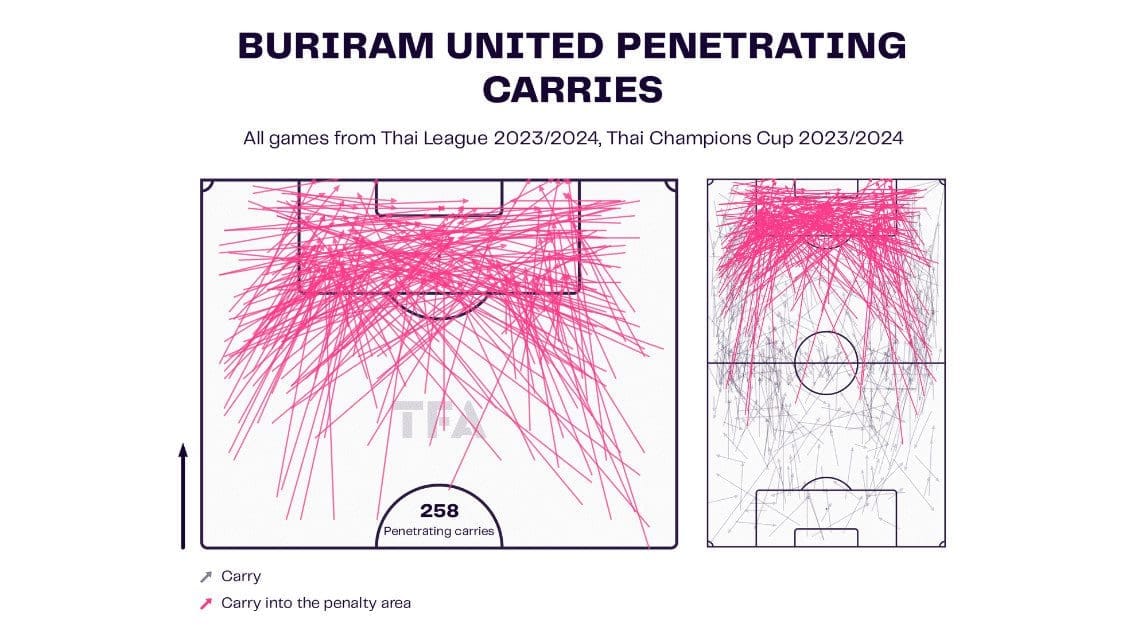
The areas from which we see penetrating carries in the final third from Buriram United are also extremely instructive. You can clearly see that Papas sets his side up and will look to find angles to have players penetrate into the opposition area either from the wide areas or from the half-spaces.
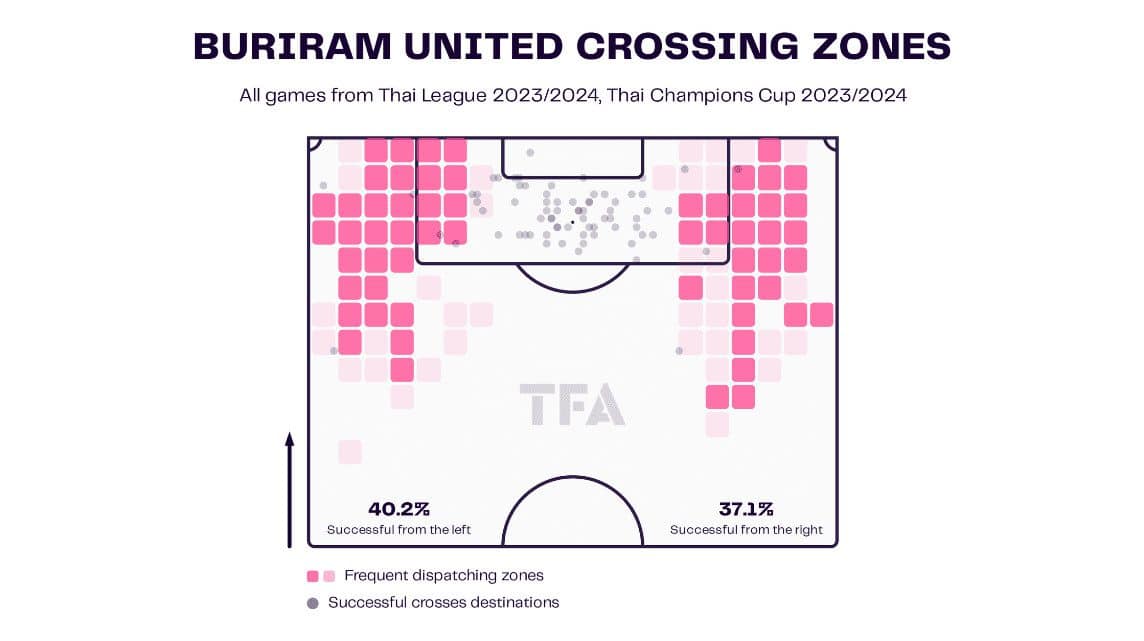
The final piece of attacking analysis that we can use to gain a better understanding of the way that the Thai side build the attack is their crossing zones. You can clearly see through this visualisation that Buriram United under Papas use the half-spaces in which to receive the ball and then look for angles to put the ball into the penalty area.
Passing and Progression
In terms of their passing and ball progression, Buriram United are definitely modern and progressive in their approach.
- 57.3% average possession (1st in Thai League)
- 398.44 passes per 90 (2nd in Thai League)
- 65.02 progressive passes per 90 (3rd in Thai League)
- 56.92 passes to final third per 90 (1st in Thai League)
While Buriram are the most possession-dominant side domestically they are also progressive in possession with an emphasis on using the possession to attack and not to simply be passive.
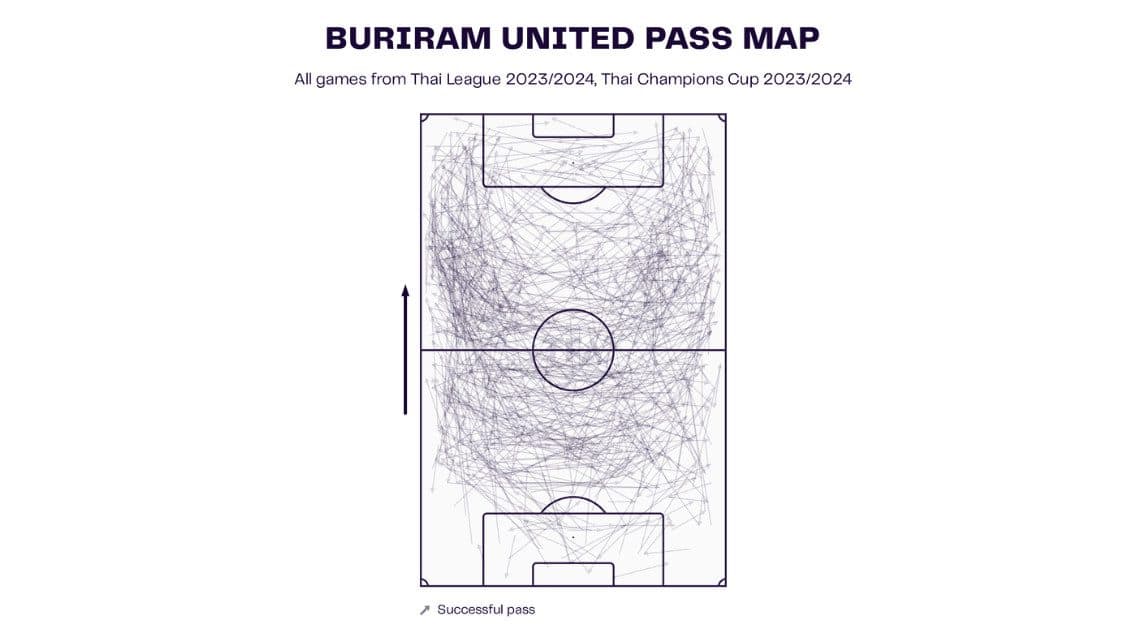
The pass map for Buriram United in the league and the Asian Champions League at the time of writing we see clearly that there is a tendency from the Thai side that in the final third, there is a clear space centrally as most of the passing is clearly focussed through the wide spaces and the half-spaces.
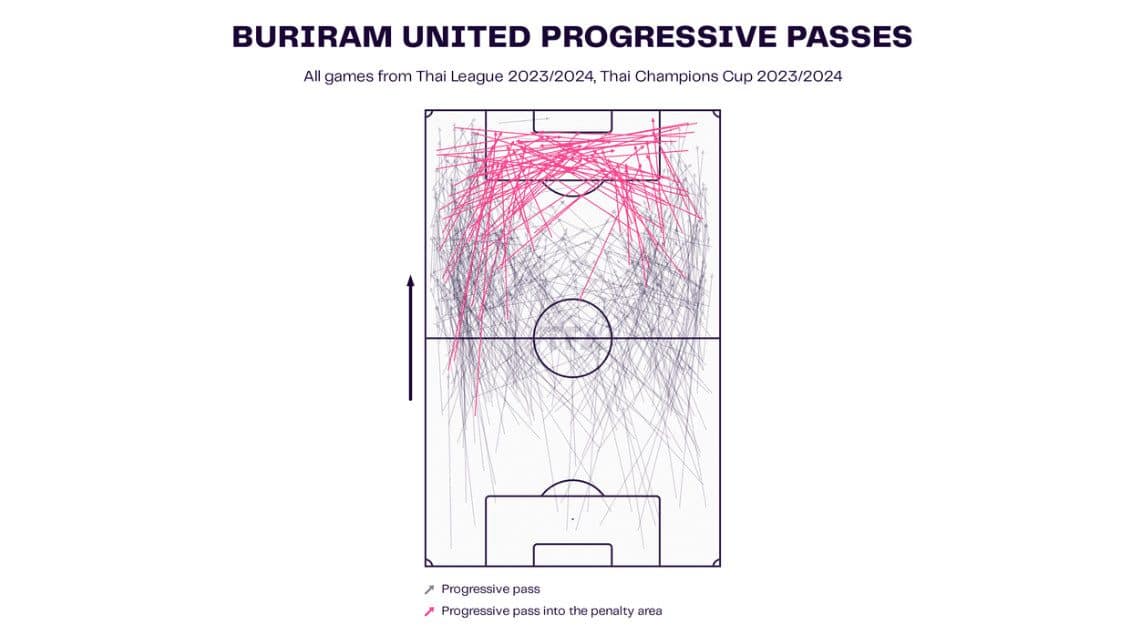
We can drill down further into the occupation of the half-spaces and the wide areas in terms of passing and progression by highlighting which passes in the pass map are classified as progressive passes. Once again we clearly see that Buriram United use the half-spaces to progress the ball through and into the opposition penalty area.
Defensive phase
In the defensive phase of the game, we also see Buriram United performing well compared to the domestic league at the time of writing.
- 3 goals conceded (1st in Thai League)
- 8.9 shots against per 90 (2nd in Thai League)
- 8.52 PPDA (4th in Thai League)
Defensively Buriram are intense in terms of their pressing and counter pressing. They limit the amount of shots their opposition can take and force them to take shots from areas that have a lower xG.
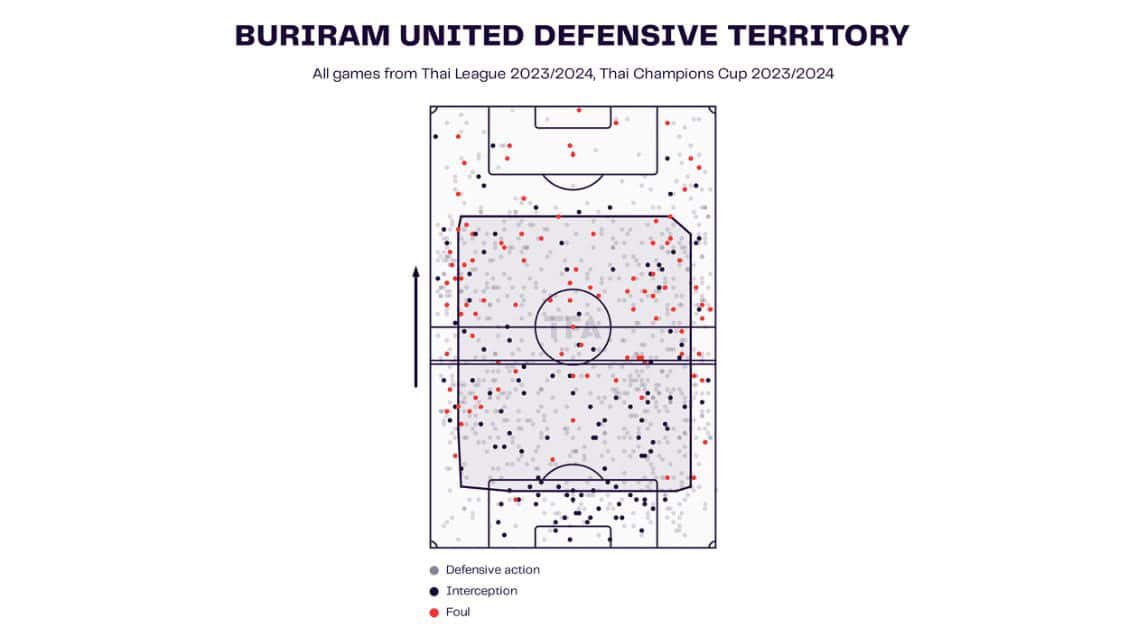
In terms of where Buriram engage in their defensive actions, we can use a heatmap as seen above to get a clearer idea of where the Thai side are completing defensive actions within the match. As you can clearly see they are aggressive defensively with a relatively high average line of engagement as well as a high volume of engagements in the opposition half.
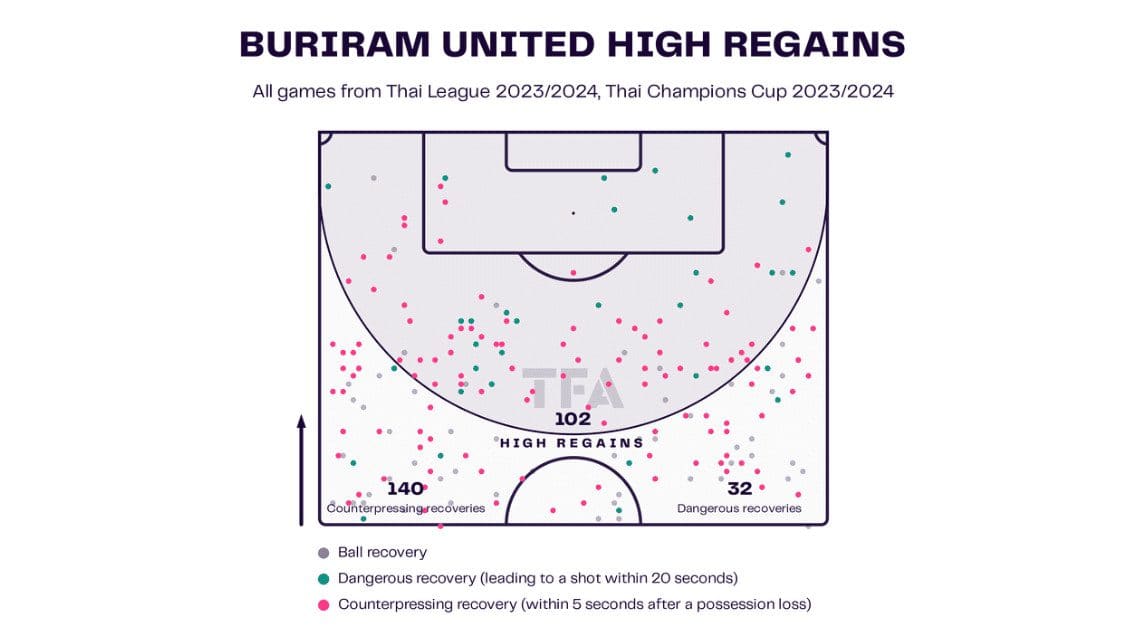
We can drill down further to better understand how they defend in high areas by looking at their high regains. In the matches in our data frame we can see that they have generated 101 high regains. 140 counter-pressing recoveries and 32 recoveries that were considered to be dangerous to the opposition.
Conclusion
Arthur Papas is an extremely interesting young coach. The fact that the tactical principles behind the team are firmly embedded to the point that the formation and structure do not matter points to an extremely effective coach. His training and onboarding of information is obviously extremely strong and his players buy into the methods because they look confident and assured when playing slightly different roles and positions. Given his modern style of play and the fact that he is an intelligent coach, Arthur Papas is a coach with a big future in the game.






Comments